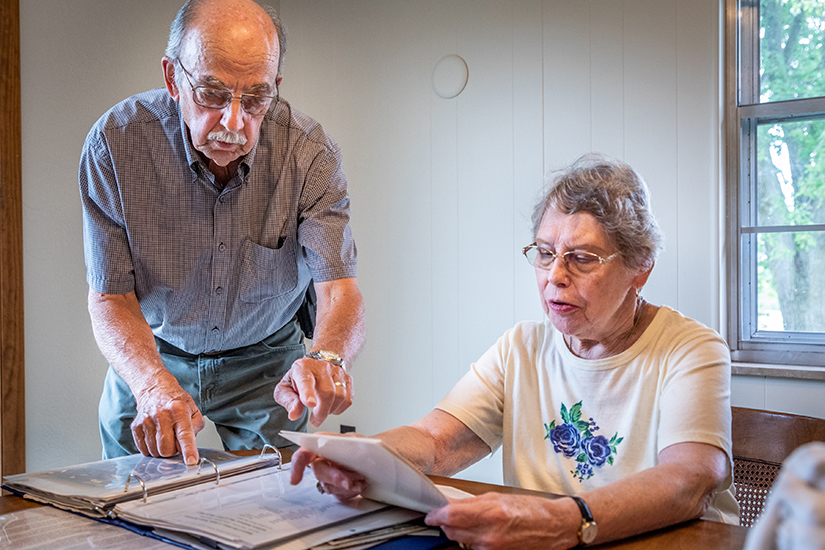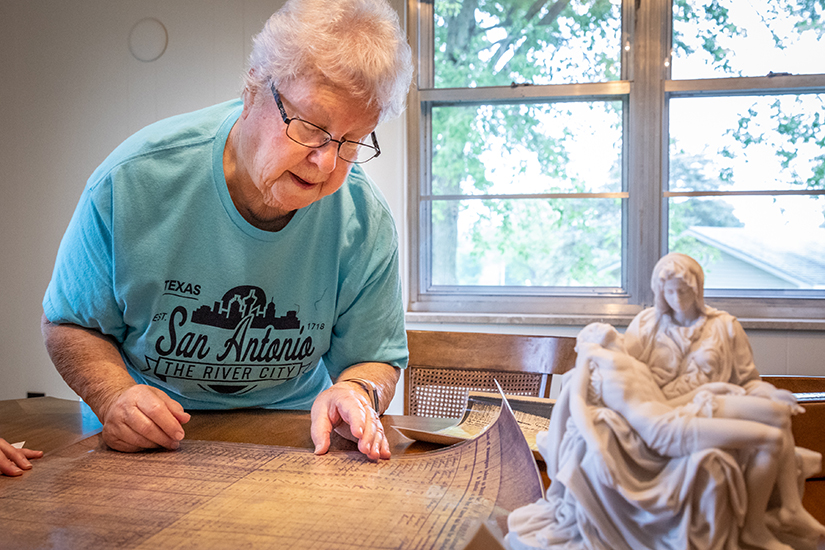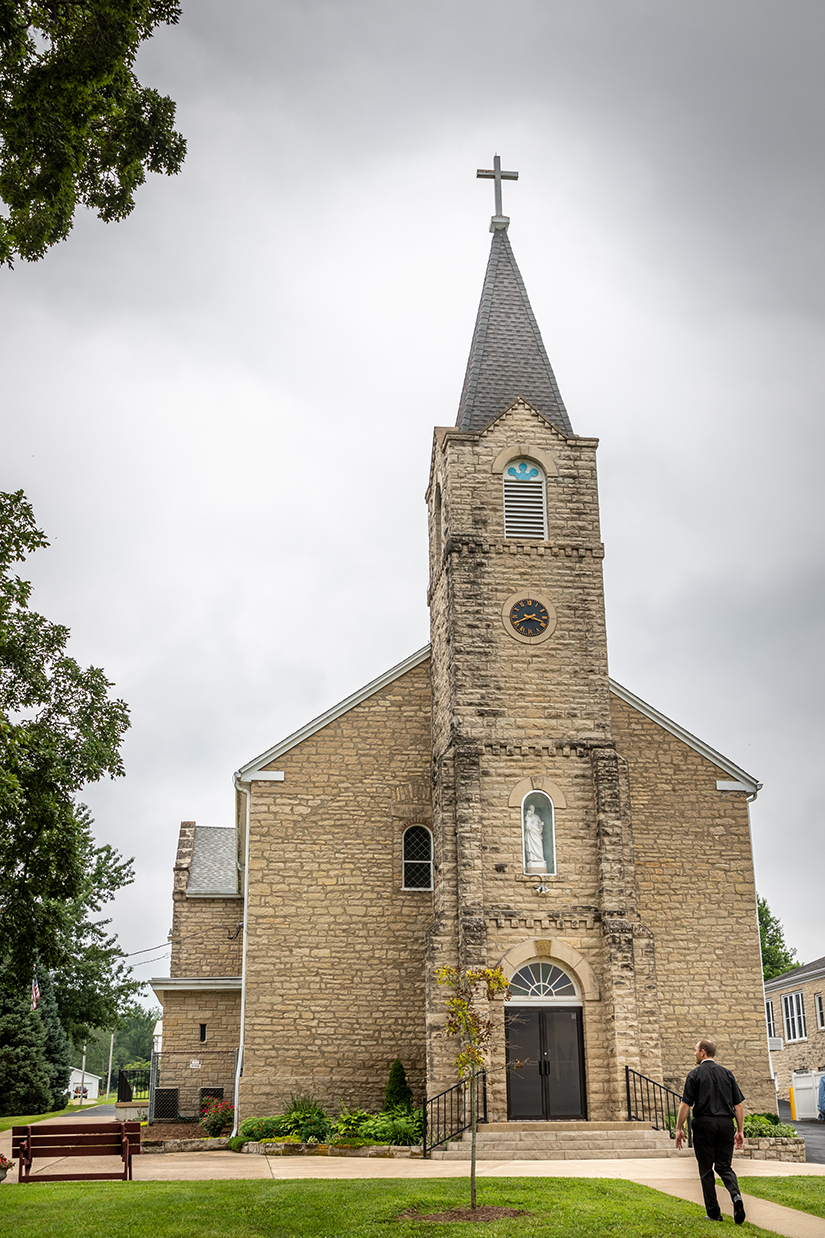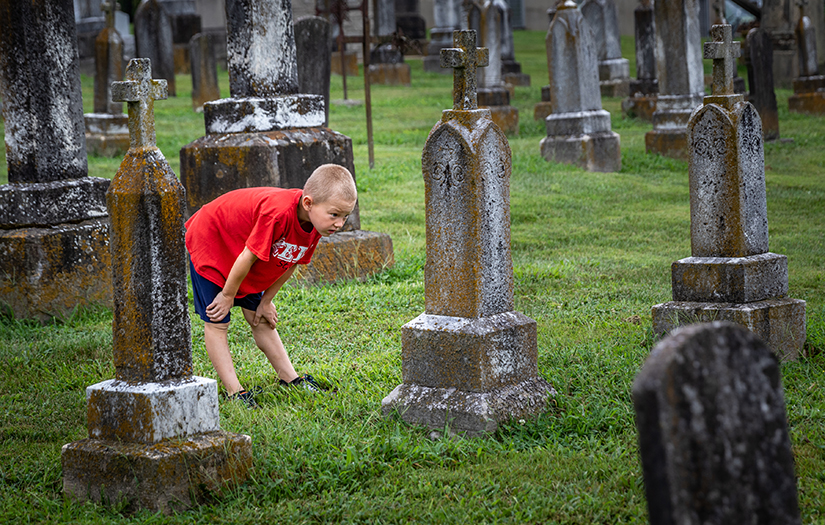 Father Henry Purcell helped Mason Roth, age 7, decipher the words on his ancestor Rosa Flieg’s tombstone at St. Joseph Parish cemetery in Zell on July 30. Mason is the great-great-great-great grandson of Rosa Flieg, who with her husband Joseph was among the first German settlers in the area.Photo Credits: Lisa Johnston
Father Henry Purcell helped Mason Roth, age 7, decipher the words on his ancestor Rosa Flieg’s tombstone at St. Joseph Parish cemetery in Zell on July 30. Mason is the great-great-great-great grandson of Rosa Flieg, who with her husband Joseph was among the first German settlers in the area.Photo Credits: Lisa JohnstonAlong Highway 32 in Ste. Genevieve County lies the land that Joseph Flieg settled upon when he immigrated from Germany to Zell in 1858.
A carpenter by trade, Joseph built a 14-by-14 foot log cabin on a hilltop overlooking a creek tributary of River Aux Vases. The home is no longer there, but six generations proceeding him have remained in the area.
The Fliegs are one of the oldest families in Zell, once known as the German Settlement, located in an area that up until then was predominantly French. Joseph’s great-grandson, Art Flieg, is among the oldest living descendants; there are 17 Flieg families still associated with St. Joseph Parish, according to family records.
Joseph is buried in the parish cemetery, which has a section including some of the original headstones inscribed in German. His wife, Rosa (Hoog) Flieg, is buried in a separate plot about 20 feet away from her husband. Of their 14 children, two brothers still have descendants in the parish — including Art Fleig, whose great-grandson, Mason Roth, is a first-grader at St. Joseph School, and great-granddaughter Vada is in pre-K. (That makes Mason and Vada the great-great-great-great grandchildren of Joseph Flieg.)
“When he came from Germany, he first stayed in St. Louis as a single man,” Art Flieg said of his great-grandfather. “He was only 17 when he came over. He worked as a cabinet maker for a couple of years until he got enough money saved up. Then he bought the original homeplace in Zell.”
Art Flieg said he’s certain it was the lush landscape that drew Joseph to the Zell area. “The geography of the terrain, it was similar to what they had over in Germany — the rolling hills and room for crops and timber. That’s what they made their living from, was farming.” Arthur and Donna Flieg looked a their family genealogy papers in St. Joseph Parish’s rectory in Zell on July 30.Photo Credits: Lisa Johnston
Arthur and Donna Flieg looked a their family genealogy papers in St. Joseph Parish’s rectory in Zell on July 30.Photo Credits: Lisa Johnston
St. Joseph Parish was born during a boom in Catholic population in the Ste. Genevieve area at the turn of the 19th century. In 1839, in the early days of the Spanish regime, Ste. Genevieve Parish (the oldest recorded parish in the Archdiocese of St. Louis, founded in 1759) put forth its missionary efforts, which included French Village, River Aux Vases and Zell. Father F.X. Dannebrog, along with Father A.H. Gandolfo, visited the outlying Catholic communities on a monthly basis.
On May 1 (the feast of St. Joseph the Worker) in 1845, the first deed was signed for the church in Zell, and it was dedicated to St. Joseph. By 1847, the parish was built and organized. St. Joseph’s first pastor, Father Francis X. Weiss, arrived in the spring 1848 to the tune of 632 parishioners. St. Joseph marked its 175th anniversary in 2020.
A number of these parishes (St. Anne, French Village, 1845; Sts. Philip and James, River Aux Vases, 1864; Our Lady, Help of Christians, Weingarten, 1872) were just getting started in the decades following Missouri’s entrance into the union as the 24th state in 1821. Some of these original parishioners, including Joseph Flieg, were drafted during the Civil War. Joseph served his adoptive state and nation as a member of the Union Army, which fought to preserve the union of the collective states.
Currently, Art Flieg and his wife, Donna, remain active at St. Joseph Parish. Art is known for helping around the parish with maintenance projects, when needed. Other families have had a long history at St. Joseph, including the names Jokerst, Eckenfels, Fischer, Huck and Roth, among others.
“It’s like another home, a place where you can go and pray,” Art Flieg said. “It’s a good place — peaceful, quiet. It opens the doors to God and helps you understand things. It’s a place to go when you have a problem … and need some time to get away. We have a pretty tight group here.” Linda Hermann looked at the ship’s manifest listing her ancestor, Mathias Naeger, as a passenger. St. Joseph Parish in Zell has several families tracing their lineage back to some of the first German settlers in the area.Photo Credits: Lisa Johnston
Linda Hermann looked at the ship’s manifest listing her ancestor, Mathias Naeger, as a passenger. St. Joseph Parish in Zell has several families tracing their lineage back to some of the first German settlers in the area.Photo Credits: Lisa Johnston
An old discovery
Linda Naeger Hermann knew her great-great-grandfather, Mathias, was buried in St. Joseph’s Cemetery. But it wasn’t until recently that she discovered his grave for the first time.
“Oh!” she exclaimed with a smile as pastor Father Henry Purcell pointed out the headstone to her. Born in 1791 in Baden, Germany, Mathias came to the United States aboard the ship “The Monument,” from Le Havre, France, arriving in New Orleans in 1843.
 Father Henry Purcell walked toward St. Joseph Church in Zell.Photo Credits: Lisa Johnston
Father Henry Purcell walked toward St. Joseph Church in Zell.Photo Credits: Lisa JohnstonSeveral years ago, Linda Hermann obtained a copy of the ship’s manifest, which listed her great-great-grandfather’s name. Mathias and his wife, Sophie, settled in Zell around the time St. Joseph Parish was founded.
Linda Hermann has eight generations in the Naeger family, although not all of her children and grandchildren attend church at St. Joseph. Some do remain in the area.
Linda Hermann grew up just outside of Ste. Genevieve and at the time was a member of Ste. Genevieve Parish. After marrying her husband, Leonard, they moved to Zell, and St. Joseph Parish, in 1962. The couple had six children; Leonard is buried in the parish cemetery.
Hermann said it’s the good people and tight-knit community that make St. Joseph Parish what it is. “It’s the people who have worshipped and supported the church and school and we’ve all become good friends,” she said. “It’s a nice place to be.”
Just like the early settlers did, parishioners continue to use their gifts and talents to support the parish community. “There’s just a handful of us ladies that quilt and it’s for the benefit of the parish,” Hermann said. “We have quilted in the basement for years. That’s what people do — if there’s a need they step up.”
>> Zell: A German farming community
Zell is named for the town of Zell am Harmersbach in the Baden region of the German state of Baden-Württemberg, from where its settlers had originally come.
As early as 1832, German immigrants began to settle in Ste. Genevieve County, which at the time was predominantly French. The area of land, located about six miles from Ste. Genevieve, was known as the Prairie Gautier Tract. The land was a 1,000 acre grant to Adrian Langlois. It was first called the German Settlement because they were the first Germans to settle in the area.
Among the first to settle in the area included the Fallert, Hermann and Roth families. (Auxiliary Bishop Emeritus Robert Hermann, who grew up in the nearby community of Weingarten, is related to the Hermanns who settled in Zell.) They traveled on the boat, The Manchester, which departed from France and arrived in the United States in 1832. The Roth group stayed in New York for nine years before coming to Zell.
Attracted by the lush, rolling hills and proximity to the river, many German families who settled here turned to farming of livestock and crops.
 Mason Roth, age 7, studied the words on his ancestor Joseph Flieg’s tombstone at St. Joseph Parish cemetery in Zell. Mason is starting school at St. Joseph this fall as a first-grader.Photo Credits: Lisa Johnston
Mason Roth, age 7, studied the words on his ancestor Joseph Flieg’s tombstone at St. Joseph Parish cemetery in Zell. Mason is starting school at St. Joseph this fall as a first-grader.Photo Credits: Lisa Johnston